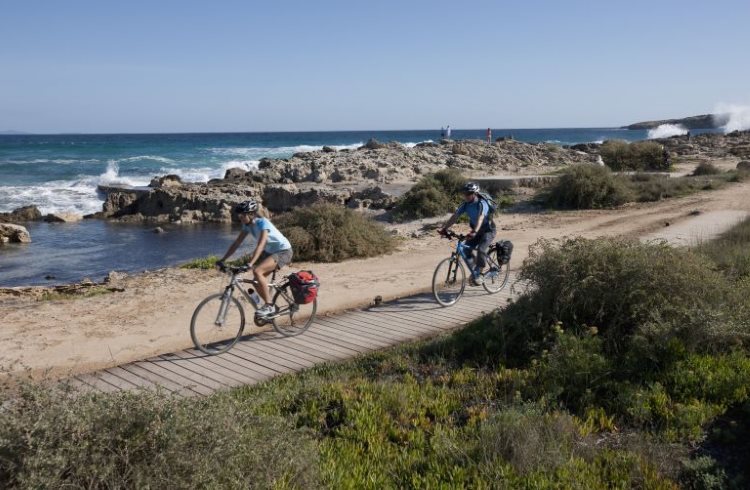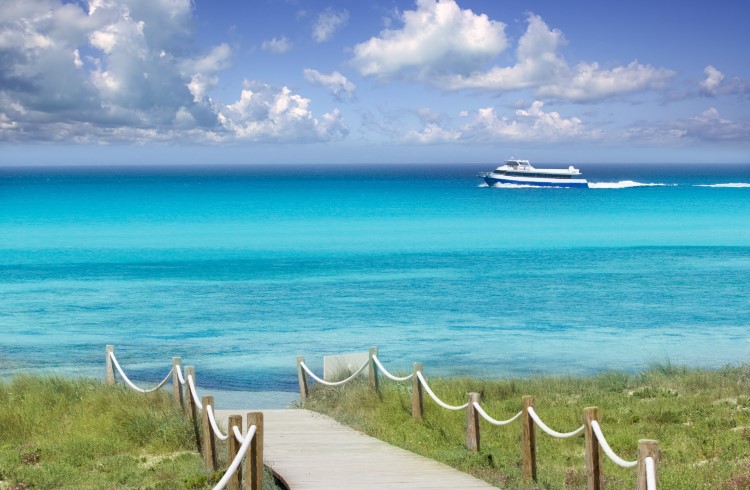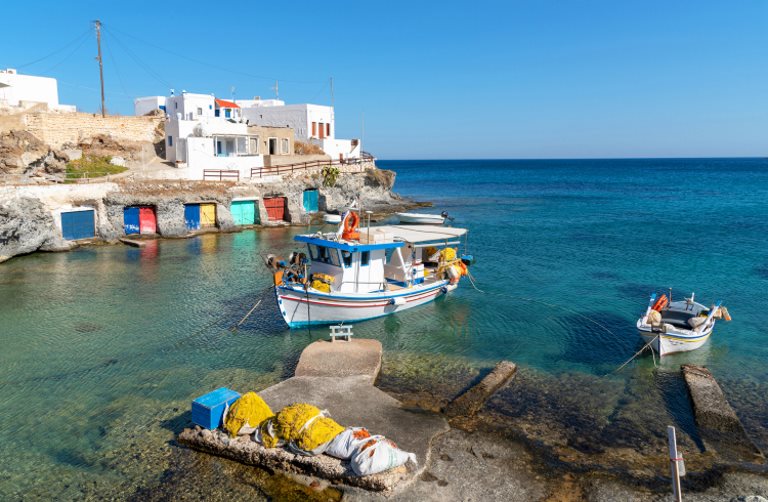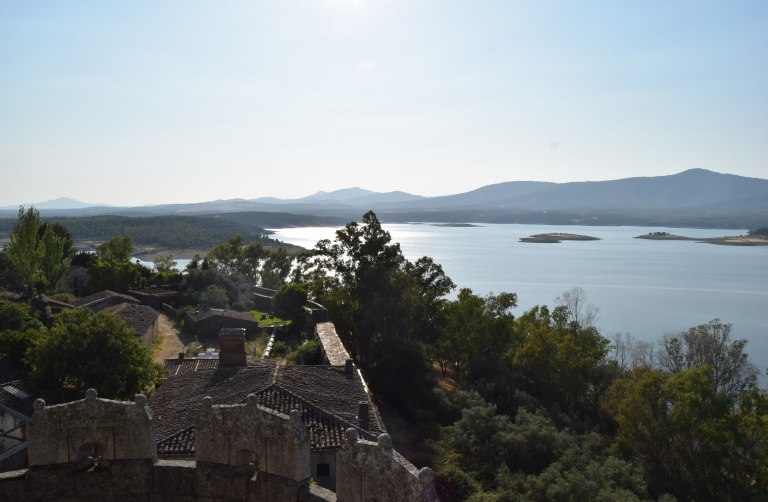A ferry crossing from the Spanish mainland is a great prelude to an eco-friendly island-hopping trip, discovering the calmer, greener side of Ibiza, Formentera, Mallorca, and Menorca.
 Photo © Getty Images / Westend61
Photo © Getty Images / Westend61
- The joys of sustainable island-hopping
- Exploring Ibiza, Formentera, Mallorca, and Menorca
- Slow food, Balearic style
- An even greener way to visit the Balearic Islands: the Super Fast car ferry
- Trip notes
The joys of sustainable island-hopping
Pedaling along a sandy track close to the shimmering, indigo-striped sea, I paused, closed my eyes and sniffed the breeze. Pine trees, orchids, rosemary, and thyme. If scents had colors, the scent of Formentera would be green.
This supremely appealing island – Ibiza’s laidback, low-key little neighbor – has green ideals, too. The track I was following was one of its 30 or so Rutes Verdes (Green Routes): intertwined pathways that invite locals and visitors to leave their cars behind and explore on foot or by bike. This pleasing network had led me past sun-drenched vineyards and ancient fig trees, and beckoned me to chiringuitos: friendly beach bars on sands so long and lovely that I never wanted to leave. Often, mini concerts called Aperitius Musicals (Musical Aperitifs) offered the perfect excuse to linger.
Formentera doesn’t have an airport, so almost everyone arrives by sea. Opting for one of the swift little ferries that shuttle between Ibiza’s Estación Marítima and Formentera’s La Savina throughout the day, my crossing had taken just 30 minutes.

Less conventionally, I had arrived in Ibiza by sea as well, having traveled from Britain to Spain by train, rather than by plane. Instead of catapulting myself like a missile from rainy, autumnal England to the sun-warmed Med, I wanted to travel lightly, rubbing shoulders with the locals and arriving utterly relaxed.
I could have hopped on a ferry in Barcelona or Valencia but opted for Dénia instead. Even though a thousand years have passed since this down-to-earth Costa Blanca town was the capital of a taifa (Moorish principality) that included Ibiza, its connections with the Balearic Islands – known in these parts simply as Les Illes – remain strong.
Exploring Ibiza, Formentera, Mallorca, and Menorca
Ibiza made the perfect starting point for my Balearic island-hopping trip. Its alternative, sustainability-conscious culture predates its party-animal reputation, and the island’s creative, caring side is more in vogue than ever. After sauntering around the Museu d’Art Contemporani d’Eivissa in Ibiza Town, I crossed the island in an electric rental car and treated myself to a room at an agroturismo – a beautiful rural hotel surrounded by succulents, wildflowers, and tucked-away coves. Instead of beats, I heard birdsong.
From Ibiza, ferries carried me northeast to Mallorca, then on to Menorca. Once again, renting an electric car made it easy to explore off the beaten track. On Mallorca, I puttered around beautiful, secluded bays: turquoise Cala Llombards, cheerful Cala Mondragó. On Menorca, a UNESCO Biosphere Reserve, there were quieter coastal stretches to discover, with superb walking routes and birdwatching spots.
I discovered, to my delight, that each island in the chain offers fresh opportunities to go sailing, swimming, and diving. Solar-powered catamaran excursions to peaceful lagoons and white-sand beaches launch from Ibiza and Formentera, both Mallorca and Menorca are superb for kayaking, and there are scuba diving sites dotting the seas around all four main islands. On Mallorca, boat trips visit the protected islets of Cabrera and Sa Dragonera, revealing hidden coves with sparkling water and some of the best snorkeling in the Med. As a water lover, I was in heaven.

Slow food, Balearic style
I ate well during my trip, so was not surprised to learn that when the COVID-19 pandemic forced the Balearic club scene to hit pause, local pleasure-seekers turned to the next best thing: food. For some, the switch from moonlit dancing to lantern-lit eating has been so refreshing, they’re not planning to go back. The Mediterranean climate is perfect for alfresco dining, after all.
The islands’ leading restaurants – eclectic, eco-chic spaces adorned with driftwood and geometric art – serve ocean-inspired dishes such as gazpacho with smoked sardines. There are slow food specialities to sample, too, including Formentera peix sec (wind-dried ray), Menorcan lobster, and Mallorcan ovella roja sheep’s cheese.
An even greener way to visit the Balearic Islands: the Super Fast car ferry
My island-hopping experience left me longing to return to the archipelago – not least because the Baleària ferry service from the Spanish mainland has had an ultra-modern, ultra-green upgrade. Now in full service, the Eleanor Roosevelt is Baleària’s pride and joy: the world’s largest Super Fast car ferry, and the first with dual engines powered by liquefied natural gas (LNG).
Launched in 2021 and named after the first president of the UN Commission for Human Rights, the Eleanor Roosevelt zips from Dénia to Ibiza in two hours flat, with up to 1,200 passengers and 450 cars on board. While LNG is not 100% green, it produces 30% lower greenhouse gas emissions than oil or diesel, and significantly less air, sea, and noise pollution. As such, it’s an important stepping stone on the path towards net zero.
Trip notes
Getting there and around
Baleària runs fast car ferries from Dénia to Ibiza (2hr, from US $64 / €54 for foot passengers, one way) and Mallorca (5hr, from US $66 / €56), and between Ibiza, Formentera, Mallorca, and Menorca. There are also ferries from Barcelona to all four islands, and from Valencia to Mallorca. Services reduce between November and April. There are bicycles, mopeds, and electric cars for hire on all four islands. Alternatively, get around by taxi or bus.
Planning your trip
Spring or autumn are lovely times to arrive in the Balearic Islands: the weather is mild and the islands have a relaxing shoulder-season vibe. Modest and mid-range guesthouses, rural hotels and agroturismos cost around US $70–235 / €60–200 per night for two, including the islands’ Sustainable Tourism Tax, which supports environmental and heritage projects. For suggestions, visit Illes Balears.
Related articles
Simple and flexible travel insurance
You can buy at home or while traveling, and claim online from anywhere in the world. With 150+ adventure activities covered and 24/7 emergency assistance.
Get a quote


No Comments